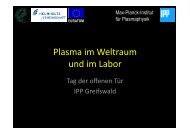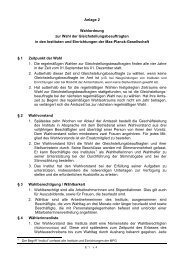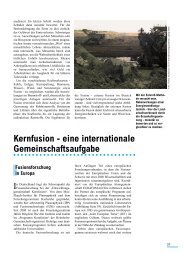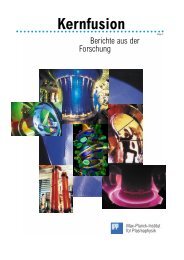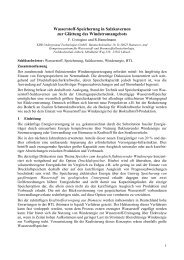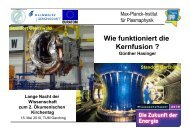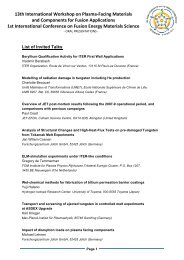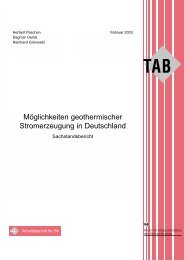IPP Annual Report 2007 - Max-Planck-Institut für Plasmaphysik ...
IPP Annual Report 2007 - Max-Planck-Institut für Plasmaphysik ...
IPP Annual Report 2007 - Max-Planck-Institut für Plasmaphysik ...
Create successful ePaper yourself
Turn your PDF publications into a flip-book with our unique Google optimized e-Paper software.
diagnostic neutral beam injection system, KFKI/RMKI in<br />
Budapest, Hungary, is developing and constructing the<br />
video diagnostic systems for W7-X, <strong>IPP</strong>LM, Warsaw is<br />
developing a neutron activation system and performing<br />
MCP calculations for W7-X, the university of Opole (Poland)<br />
is preparing a C/O monitor diagnostic and the Akademia<br />
Morska, Szczechin and the Szczechin University of Technology<br />
are investigating the sightline of the Interfero-<br />
Polarimeter and different microwave based polarimeter and<br />
interferometer methods, CIEMAT investigates potential and<br />
components for CO 2 -Intefererometry, IST participates in<br />
developing fast tomographic inversion methods (P. Carvalho<br />
4 Months stay in Greifswald) and is developing ADC/DAQ<br />
stations being linked to XDV, PTB, Braunschweig is performing<br />
preparatory work for a contract on the development<br />
of a Neutron-Counter System for W7-X and IOFFE <strong>Institut</strong>e<br />
St. Petersburg, the Culham Science Centre (UKAEA) and<br />
CIEMAT in Madrid are collaborating in the field of CX-<br />
Neutral Particle Analysis.<br />
8 Heating<br />
8.1 Project Microwave Heating for W7-X (PMW)<br />
The Electron Cyclotron Resonance Heating (ECRH) system<br />
for W7-X is being developed and built by FZ Karlsruhe<br />
(FZK) as a joint project with <strong>IPP</strong> and IPF Stuttgart. The<br />
“Project Microwave Heating for W7-X” (PMW) coordinates<br />
all engineering and scientific activities in the collaborating<br />
laboratories and in industry and is responsible for the entire<br />
ECRH system for W7-X. ECRH is designed for a microwave<br />
power of 10 MW in continuous wave (CW) operation<br />
(30 min) at 140 GHz, which is resonant with the W7-X magnetic<br />
field of 2.5 T. It will consist of ten Gyrotrons with<br />
1 MW power each, a low loss quasi-optical transmission<br />
line and a versatile in-vessel launching system. It was<br />
shown recently, that the gyrotrons operate also at 103.6 GHz<br />
with about half the output power, which would extend the<br />
flexibility of the ECRH significantly. PMW is strongly<br />
involved in advanced and ITER related R&D activities.<br />
8.1.1 The W7-X Gyrotrons (FZK)<br />
The TED-Gyrotrons SNo. 2 and 3 failed to meet the specified<br />
output power in the acceptance tests and were sent back<br />
to TED for inspection. Strong defects in the electron beam<br />
tunnel between gun and cavity were identified, which were<br />
believed to be the reason for the measured power limitation.<br />
TED presented a failure analysis indicating a fabrication<br />
problem during brazing of these parts. An improved procedure<br />
for the manufacture was qualified and the critical parts<br />
were replaced in both, the SNo. 2 and 3 Gyrotrons. The<br />
SNo. 2 (repair) Gyrotron was delivered to FZK by end of<br />
July, where an output power of 0.55 MW/30 min and<br />
0.85 MW/3 min were achieved, respectively. Then a water<br />
Wendelstein 7-X<br />
55<br />
leak opened at the cw dummy load in the test stand, which<br />
prevented further long pulse testing. The gyrotron was<br />
shipped to <strong>IPP</strong>, where the FAT will be continued in January.<br />
As short-pulse testing is still possible in the FZK test stand,<br />
the Gyrotron SNo. 3 (repair) was installed by fall of the year<br />
and short pulse testing has started. The Gyrotron SNo. 4 was<br />
also equipped with the improved beam tunnel and passed<br />
the Factory Acceptance Test (FAT) at FZK successfully<br />
(0.5 MW/30 min, 0.91 MW/3 min). The gyrotron was then<br />
transferred to <strong>IPP</strong>-HGW for the site acceptance test (30 min),<br />
where 0.83 MW were achieved for 8 min, as the tests had to<br />
be stopped, because the rf-beam parameters showed some<br />
deterioration after a cooling failure. The gyrotron was<br />
shipped to TED for inspection. The W7-X gyrotrons are<br />
optimized for single frequency operation at 140 GHz. As the<br />
gyrotron diamond window has a resonant thickness of 4λ/2<br />
at 140 GHz, it is, however, also transparent at 105 GHz corresponding<br />
to 3λ/2. Two modes, the TE 21,6 (103.6 GHz) and<br />
TE 22,6 (106.3 GHz) exist in the vicinity of the desired frequency.<br />
Both modes could be exited by tuning the resonant<br />
magnetic field and adjusting the operation parameters<br />
(I beam =40 A and U acc =62 kV). We have focused on the<br />
TE 21,6 -mode operation, because the output beam was almost<br />
perfectly centered on the output window, whereas the beam<br />
from the TE 22,6 -mode was located somewhat off centre. As<br />
seen from figure 27 (above), a maximum output power of<br />
about 0.52 MW was achieved without collector voltage<br />
depression corresponding to an efficiency η=21 %, which is<br />
slightly higher than the theoretical prediction of η =17 %.<br />
The output power drops with increasing depression voltage<br />
while the efficiency increases from 21 % to 27 %. The corresponding<br />
collector loading at 0 and 8 kV depression voltage<br />
is 1.9 and 1.7 MW, respectively, which is incompatible<br />
with the collector-loading limit of 1.3 MW. Thus only operation<br />
with reduced beam current around 34 A (about 400 kW)<br />
can be handled safely by the collector. The rf-beam was<br />
transmitted through 7 mirrors of the quasi-optical transmission<br />
line into a calorimetric cw-load. Transmission losses<br />
of about 20 kW were measured, which compares well with<br />
the transmission loss fraction at 0.9 MW, 140 GHz operation.<br />
It is worth noting, that both the beam matching mirrors<br />
as well as the set of polarizers can be used without modification.<br />
The larger beam size at the lower frequency is expected<br />
to introduce slightly higher losses as compared to<br />
the nominal frequency. On the other hand the atmospheric<br />
absorption is somewhat lower.<br />
Assuming, that all series gyrotrons behave similar to the<br />
Prototype, ECRH for W7-X will be operated as a two-frequency<br />
system. As sketched in figure 27 the operation range<br />
of experiments can then be extended towards different resonant<br />
magnetic field of 1.86 T (X2 and O2 mode) and 1.25 T<br />
(X3 mode), respectively. Once plasma start-up could be<br />
achieved with X3-mode, which is not clear yet, operation at




